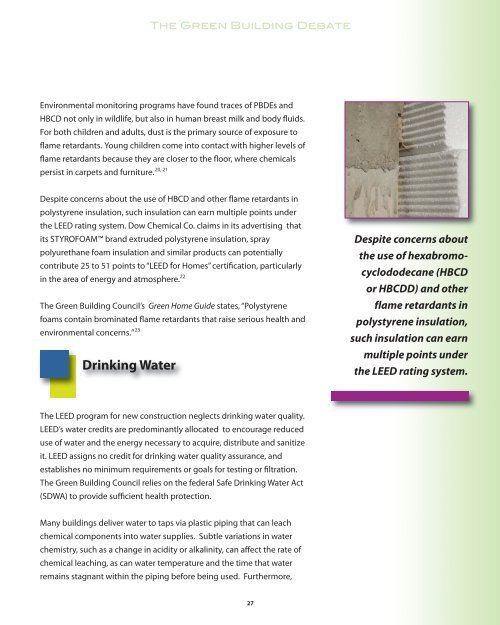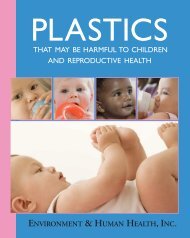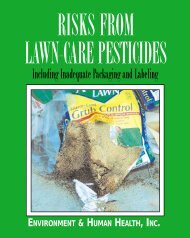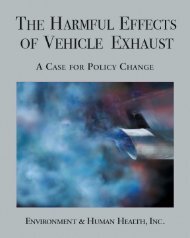LEED Report - Environment & Human Health, Inc.
LEED Report - Environment & Human Health, Inc.
LEED Report - Environment & Human Health, Inc.
- No tags were found...
You also want an ePaper? Increase the reach of your titles
YUMPU automatically turns print PDFs into web optimized ePapers that Google loves.
The Green Building Debate<strong>Environment</strong>al monitoring programs have found traces of PBDEs andHBCD not only in wildlife, but also in human breast milk and body fluids.For both children and adults, dust is the primary source of exposure toflame retardants. Young children come into contact with higher levels offlame retardants because they are closer to the floor, where chemicals20, 21persist in carpets and furniture.Despite concerns about the use of HBCD and other flame retardants inpolystyrene insulation, such insulation can earn multiple points underthe <strong>LEED</strong> rating system. Dow Chemical Co. claims in its advertising thatits STYROFOAM brand extruded polystyrene insulation, spraypolyurethane foam insulation and similar products can potentiallycontribute 25 to 51 points to “<strong>LEED</strong> for Homes” certification, particularlyin the area of energy and atmosphere. 22The Green Building Council’s Green Home Guide states, “Polystyrenefoams contain brominated flame retardants that raise serious health andenvironmental concerns.” 23Drinking WaterDespite concerns aboutthe use of hexabromocyclododecane(HBCDor HBCDD) and otherflame retardants inpolystyrene insulation,such insulation can earnmultiple points underthe <strong>LEED</strong> rating system.The <strong>LEED</strong> program for new construction neglects drinking water quality.<strong>LEED</strong>’s water credits are predominantly allocated to encourage reduceduse of water and the energy necessary to acquire, distribute and sanitizeit. <strong>LEED</strong> assigns no credit for drinking water quality assurance, andestablishes no minimum requirements or goals for testing or filtration.The Green Building Council relies on the federal Safe Drinking Water Act(SDWA) to provide sufficient health protection.Many buildings deliver water to taps via plastic piping that can leachchemical components into water supplies. Subtle variations in waterchemistry, such as a change in acidity or alkalinity, can affect the rate ofchemical leaching, as can water temperature and the time that waterremains stagnant within the piping before being used. Furthermore,27







